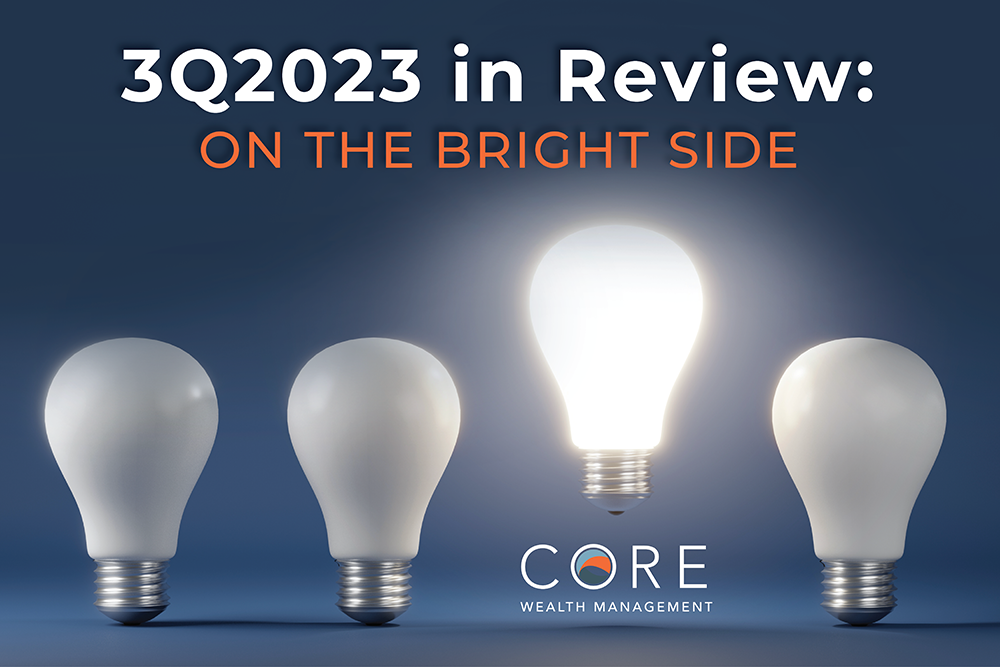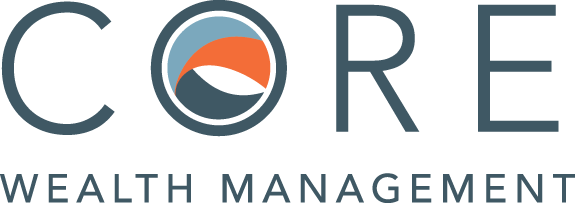
The end of the third quarter of 2023 brought some challenges in the financial markets. The S&P 500 fell -4.9% in September and the MSCI All Country World index dropped -5.08% for the month, driven by a sudden spike in long term interest rates. That was in the context of some dour headlines, including:
- China Slips Into Deflation in Warning Sign for World Economy
- Rising Long-Term Interest Rates are Posing the Latest Threat to a US Economic ‘Soft Landing’
- S&P 500 Suffers Biggest Monthly Loss This Year
- Fed’s Bid to Avoid Recession Tested by Yields Nearing 20-Year Highs
- A Shutdown is Looming. What Comes Next?
And that was before the horrific turmoil in the Middle East.
So, where do things stand as far as the markets and the economy? As usual, for every dark cloud, there is usually a silver lining.
- A negative quarter. For the quarter ending 9/30/2023, both stocks and bonds recorded negative returns, with US stocks (as measured by the Russell 3000 Index), global stocks (as measured by the MSCI All Country World Index), and the US bond market (as measured by the Barclays Aggregate Bond Index) all declining by approximately 3.25%.
On the bright side, year-to-date returns remain positive, with the S&P 500 up 8.1% and the MSCI All Country World index gaining 6.2% through September 30. Trailing 12-month returns for broad stock market indices are up more than 20%.
- Inflation is still too high. Despite 18 months of Federal Reserve interest rate hikes, the annual change in the Consumer Price Index (“CPI” for All Urban Consumers) measured 3.7% in September, still higher than the Fed’s inflation target of 2%. The cumulative change in the CPI price level since the beginning of 2021 is approximately 18%.
On the bright side, the inflation rate has moderated from a high of 9% in the summer of 2022, to its current rate of 3.7%. Plus, forward looking inflation expectations as measured by the “5-year Breakeven Inflation Rate”, our best tool for forecasting inflation, is now just 2.18% (https://fred.stlouisfed.org/series/T5YIE).
- Interest rates continue to climb. The yield on 10-year Treasury Bond began the quarter at 3.85%, and ended the quarter at 4.58%, despite a slowdown in Fed rate hikes.
On the bright side, higher interest rates mean higher income for savers and investors. Rates on CDs, savings accounts, and fixed income securities are in the 4-5% range and are finally offering a return that exceeds inflation. In addition, higher returns on risk-free assets should push expected returns for risky assets such as stocks and real estate higher.
- Recession is possible. Slowing employment growth, higher costs of capital, a tightening banking sector, and slowing growth abroad present economic headwinds that could tip the economy into recession. Also, short-term rates exceed long-term rates (“inverted yield curve”), which is a common recession indicator.
On the bright side, certain sectors appear to have already “priced in” a recession. For example, small company stocks, value stocks and stocks outside of the US, especially emerging market stocks, are considerably “cheaper” than the broadly followed S&P 500 according to several measures, such as price-to-earnings (“P/E”) and price-to-book value.
So what does this all mean for investors?
- Be prepared for volatility. Accepting volatility as a normal part of the investment process is crucial to investment success, and planning for that volatility is a cornerstone of any sound financial plan. Funds needed in the shorter term should be set aside in less volatile investments like savings accounts or short-term bond funds so that you do not find yourself in a position where you have to sell to meet your liquidity needs at an inopportune time.
- Pay attention to cash flow. With higher rates, the income produced by your diversified portfolios will likely be higher than it has been in the past. We estimate that a balanced portfolio may produce investment income (interest and dividends) that is 40-50% higher than just a few years ago. Finally, something that is keeping up with inflation!
- Keep in mind that the markets are forward-looking. If we do end up going into recession, the market will likely decline, but chances are that it will be before we even know we are in a recession, and the inevitable rebound could be quick. For some sectors of the market, this recession related decline may have happened already.
- Remember what you are investing in. It’s always useful to keep in mind that our investments are not numbers on a screen or a monthly statement. We are investing in thousands of well-managed, well-financed, innovative companies working tirelessly to overcome challenges, deliver goods and services that offer value, and ultimately produce a return for us, their investors.
The current economic environment presents challenges, but also opportunities. By focusing on long-term goals, diversifying holdings, and staying invested, short-term periods of volatility should be a blip on the path to achieving your financial goals. As usual, our advice is to maintain perspective, stick to your plan, and let the economy’s dynamic nature work for you over time.
